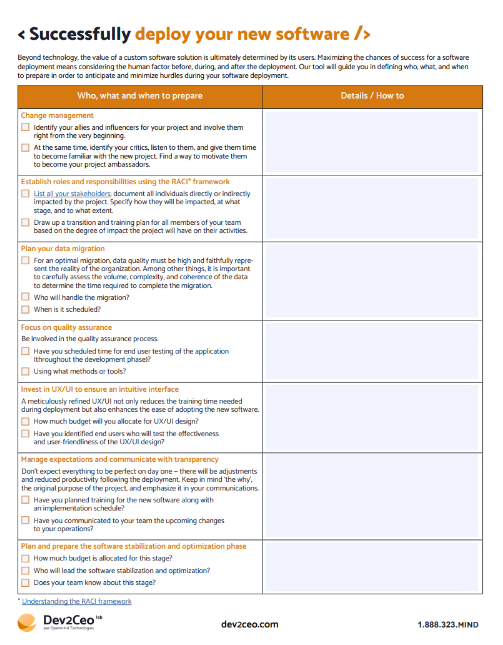Your guide to project deployment & production success
Discover essential advice for bringing your software project to life and access a comprehensive checklist for smooth application deployment into production.

Software deployment is a crucial stage in its development cycle. It’s the moment when design and programming efforts are translated into an operational version, ready for use by end-users. However, there’s more to a successful deployment than simply launching a few lines of code.
In this article, we’ll explore the 10 essential steps to successful project deployment, focusing on best practices, pitfalls to avoid and tools available to facilitate the process. Whether you’re a developer, project manager or operations manager, these tips will help you ensure successful deployments and an optimal user experience.

Discover essential advice for bringing your software project to life and access a comprehensive checklist for smooth application deployment into production.

Before embarking on deployment, take the time to carefully review the available documentation. Be sure to validate the possible release periods and check the existence of the deployment plan. If it doesn’t exist, take the initiative and create one. The documentation should be accessible in the customer’s Handbook and contain all the steps to be followed, as well as any special scenarios to be anticipated.
Make sure that the deployment version in Jira corresponds exactly to what is to be deployed in production. This step involves validation in collaboration with the development team, the Product Owner and the Scrum Master.
Before setting a deployment date, make sure it’s convenient for everyone involved. Avoid deployments after noon on Thursday, preferring Monday to Thursday mornings. It’s essential to confirm the customer’s availability for production deployment and to validate the best time slot together. Also make sure that the customer has carried out UAT (User Acceptance Testing).
Before deploying in production, thoroughly test the procedure on test environments, especially in UAT. Make sure you have meaningful data, and check the validity of database scripts and rollback capabilities.
Before deploying the system in production, make sure you have a detailed plan to follow scrupulously. This plan should be in line with the previously validated documentation.
Once deployed, test immediately on the production environment. Check the Critical Path and make sure that the application’s critical functions are working properly, in particular by performing a spot check.
After deployment, keep an eye out for error notifications by closely monitoring server and Sentry logs.
Once the deployment is complete, confirm to the Product Owner and the customer that everything has gone according to plan. Publish the deployed version in Jira and send an e-mail to inform them of the completion of the deployment, and if necessary, of any guarantees linked to the new functionalities.
Subscribe to receive our exclusive updates directly to your email.

Document any anomalies or special cases arising during deployment in the project documentation.
If your project doesn’t yet have a CI/CD, consider setting one up with the DevOps team. CI/CDs simplify deployments and reduce the risk of human error.
In conclusion, successful project deployment requires a methodical and rigorous approach. From initial planning to post-deployment monitoring, each step is crucial to ensuring the smooth running of the application and user satisfaction. By following the 10 steps we’ve outlined in this article, you’ll be better prepared to meet the challenges of deployment and ensure the success of your projects.
Don’t forget that deployment is not just a technical step, but also a process that involves collaboration between teams, transparent communication with stakeholders and a culture of continuous improvement. By integrating these principles into your approach to deployment, you’ll be able to deliver high-quality products consistently and reliably, while minimizing the risk of incidents and maximizing value for your users.
Tell us more about your needs so that we can better route your project to our specific SWAT team.
1
During the brainstorming phase, we work with you to identify potential solutions to your business challenges to generate the technology response that aligns with your business objectives.
2
Through our requirements gathering process, we work closely with you to define and prioritize your needs, ensuring that our solutions are tailored to meet your specific requirements.
3
This phase marks the beginning of our partnership. We’ll finalize the project plan and establish clear communication channels to ensure a smooth and successful project execution.